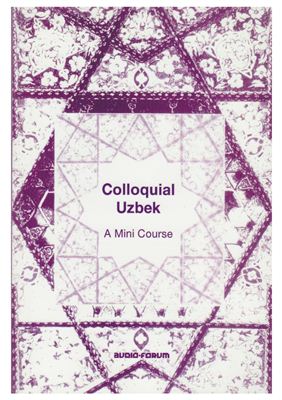Madison, Connecticut: Audio-Forum, 1994. - 54p.
How to Use This Course
Colloquial Uzbek is designed to fulfill the basic communication needs of those who wish to communicate in an Uzbek speaking environment. Since it is a communication/survival based course, its goal is to give the user certain structures along with a sufficient amount of vocabulary to be used to communicate with Uzbek speakers and in certain situations that the user will encounter when (s)he is traveling in Uzbekistan. Long grammatical explanations are avoided, however the mastery of this course will also give the user a sense of the basic Uzbek grammar upon which one can build his/her knowledge to study the language and literature of the Uzbeks.
Uzbek is an agglutinating language, that is to say new words are obtained by adding suffixes (and occasionally non-Uzbek prefixes) to the roots or stems of words. Some other important features of Uzbek include the following: absence of gender and the definite article, absence of duality in nouns and verbal forms, use of postpositions instead of prepositions, inflection of nouns for case, subject object verb syntax, modifiers preceding the modified head nouns, and passive, causative, reflexive, reciprocal and negative forms obtained by suffixes that are added to the verb.
This course consists of 15 chapters and 3 audio cassettes. Two cassettes cover the course given in the book and one cassette contains pronunciation and grammar/situational based drills. There is no specific order to be followed. It is however a good idea first to begin mastering certain portions such as common phrases, frequently used questions, personal and demonstrative pronouns, and numbers etc. because most other sections will require the use of some of this information. The user, through situational dialogues, is given a wide variety of more frequently used sentence structures such as nominal sentences, there is/are sentences, and some of the commonly used verbal sentences. Mastery of this infor-
mation will give the user a basis for reproducing an infinite number of similar structures as (s)he expands his/her vocabulary. Materials on cassettes may be used separately or together with the book. The user may listen to the cassettes by using a walkman-type cassette player any time or anywhere (s)he wishes to. Reference cards are prepared to give the user easy and convenient access to the most frequently needed questions, requests, phrases and vocabulary; they could conveniently be used in probably any environment.
One last piece of advise to the user of this or any other language course. When leaing a new language it is better to study it as frequently as possible. So it is better to spend 20 minutes studying it every day rather than two or three hours once a week. Try to use your newly acquired knowledge whenever the opportunity arises.
How to Use This Course
Colloquial Uzbek is designed to fulfill the basic communication needs of those who wish to communicate in an Uzbek speaking environment. Since it is a communication/survival based course, its goal is to give the user certain structures along with a sufficient amount of vocabulary to be used to communicate with Uzbek speakers and in certain situations that the user will encounter when (s)he is traveling in Uzbekistan. Long grammatical explanations are avoided, however the mastery of this course will also give the user a sense of the basic Uzbek grammar upon which one can build his/her knowledge to study the language and literature of the Uzbeks.
Uzbek is an agglutinating language, that is to say new words are obtained by adding suffixes (and occasionally non-Uzbek prefixes) to the roots or stems of words. Some other important features of Uzbek include the following: absence of gender and the definite article, absence of duality in nouns and verbal forms, use of postpositions instead of prepositions, inflection of nouns for case, subject object verb syntax, modifiers preceding the modified head nouns, and passive, causative, reflexive, reciprocal and negative forms obtained by suffixes that are added to the verb.
This course consists of 15 chapters and 3 audio cassettes. Two cassettes cover the course given in the book and one cassette contains pronunciation and grammar/situational based drills. There is no specific order to be followed. It is however a good idea first to begin mastering certain portions such as common phrases, frequently used questions, personal and demonstrative pronouns, and numbers etc. because most other sections will require the use of some of this information. The user, through situational dialogues, is given a wide variety of more frequently used sentence structures such as nominal sentences, there is/are sentences, and some of the commonly used verbal sentences. Mastery of this infor-
mation will give the user a basis for reproducing an infinite number of similar structures as (s)he expands his/her vocabulary. Materials on cassettes may be used separately or together with the book. The user may listen to the cassettes by using a walkman-type cassette player any time or anywhere (s)he wishes to. Reference cards are prepared to give the user easy and convenient access to the most frequently needed questions, requests, phrases and vocabulary; they could conveniently be used in probably any environment.
One last piece of advise to the user of this or any other language course. When leaing a new language it is better to study it as frequently as possible. So it is better to spend 20 minutes studying it every day rather than two or three hours once a week. Try to use your newly acquired knowledge whenever the opportunity arises.

